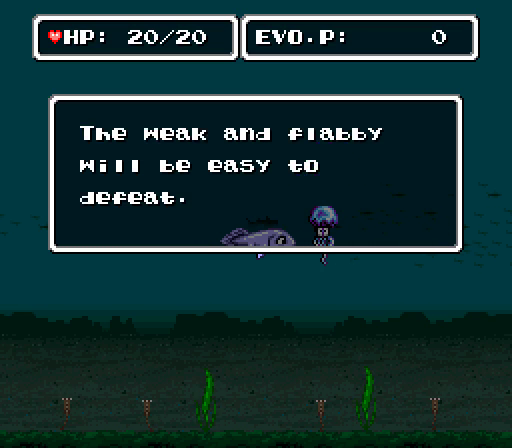E.V.O.: Search for Eden
| |
Player's Review
Spanning a period of over a billion years, the game's story involves Gaia, the embodiment of Earth, guiding the player, an embodiment of life, through five distinct geological periods of the planet's history. Beginning the game as a fish, the player must travel across the world defeating enemies and gaining the strength to evolve into more powerful and complex organisms to eventually dominate their ecosystems and thus earn the right to enter the paradise realm of Eden, becoming Gaia's immortal partner.
E.V.O.: Search for Eden (known in Japan as 46 Okunen Monogatari: Harukanaru Eden E, "4.6 Billion Year Story: To Distant Eden" ) is an 1992 action-RPG developed by Almanic Corporation and published by Enix for the SNES. The game is heavily based on Almanic's original title, 46 Okunen Monogatari: The Shinka Ron ( "4.6 Billion Year Story: The Theory of Evolution" ), released exclusively in Japan for the PC-9801 home computer in 1990.
Players must navigate a creature of their own design across a number of environments resembling Earth's past. The game is divided into five distinct geological periods: the Cambrian Period, the Ordovician Period, then the Carboniferous period, the Mesozoic Era, the late Neogene period, and the early Quaternary period. While each era takes historical liberties with both its inhabitants and time frames, the player's choices for evolution are dependent on the current era of play, ranging from aquatic bodies during the Age of Fish to mammalian physiology during the Age of Man.
Sadly, the English localization for this game is very bad. Most zoological names for the creatures and upgrades are wrong (like "Tritops" instead of Triceratops, "Tyrasaurus" instead of Tyrannosaurus, and many, many more). A lot of sentences are likely roughly translated and are hard to comprehend as well. The original Japanese team went as far as asking local biology teachers for advice, but the localization team obviously did not even proofread their work.
During the playthrough, I show all upgrades and alternative evolution paths you can take. Because of this, I did a lot of grinding, which I did not edit out in order to show gradual changes in my character. After completing the game, I show alternative cutscenes and dialogue responses, and other stuff that could not be shown during the playthrough. I hope I will not upset any zoology buffs with the simplistic names I used for my recorded creatures.
E.V.O.: Search for Eden (known in Japan as 46 Okunen Monogatari: Harukanaru Eden E, "4.6 Billion Year Story: To Distant Eden" ) is an 1992 action-RPG developed by Almanic Corporation and published by Enix for the SNES. The game is heavily based on Almanic's original title, 46 Okunen Monogatari: The Shinka Ron ( "4.6 Billion Year Story: The Theory of Evolution" ), released exclusively in Japan for the PC-9801 home computer in 1990.
Players must navigate a creature of their own design across a number of environments resembling Earth's past. The game is divided into five distinct geological periods: the Cambrian Period, the Ordovician Period, then the Carboniferous period, the Mesozoic Era, the late Neogene period, and the early Quaternary period. While each era takes historical liberties with both its inhabitants and time frames, the player's choices for evolution are dependent on the current era of play, ranging from aquatic bodies during the Age of Fish to mammalian physiology during the Age of Man.
Sadly, the English localization for this game is very bad. Most zoological names for the creatures and upgrades are wrong (like "Tritops" instead of Triceratops, "Tyrasaurus" instead of Tyrannosaurus, and many, many more). A lot of sentences are likely roughly translated and are hard to comprehend as well. The original Japanese team went as far as asking local biology teachers for advice, but the localization team obviously did not even proofread their work.
During the playthrough, I show all upgrades and alternative evolution paths you can take. Because of this, I did a lot of grinding, which I did not edit out in order to show gradual changes in my character. After completing the game, I show alternative cutscenes and dialogue responses, and other stuff that could not be shown during the playthrough. I hope I will not upset any zoology buffs with the simplistic names I used for my recorded creatures.







No Comments have been Posted.